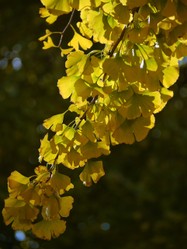Integral to the book is Thomas' life at Tullynally, a renowned arboretum [tree garden] in County Westmeath in the middle of Ireland. The arboretum, which is an estate covering many acres, is centred on Pakenham's stately home, which has been in the hands of his family since the seventeenth century. He is, in fact,the eighth earl of Longford, though he makes no use of his title in the book, and it seems that he wears it but lightly.
We are let into the difficulties, dangers and joys of running an arboretum in Westmeath,a boggy county in the middle of Ireland. There is the tale of one particularly dangerous incident when Thomas went out late in the day without a mobile phone or a torch to check on a bog fire, a problem in parts of Ireland in dry conditions, when the wind changed and cut off his escape route. The only way out was for this man of seventy nine to crawl in the dark of a country night through a rhododendron thicket before collapsing with exhaustion on a stony knoll. He was awakened by the torches of a search party led by his eldest son, who was in no hurry to find that he had become the ninth earl.
Thomas tells of his successes and failures in bringing in a variety of trees, including a rich range of acers, including maples, and his struggles to bring in the gingko biloba, a relict kind of tree. Pakenham is no friend of those who only want to grow native trees, whom he considers extremists and describes as Talibans. I was surprised to know that prior to one of the ice ages the gingko flourished in Britain and Ireland, so he believes that he is reintroducing a native.
Some interesting history is woven into the book. He explains why a line of trees was planted to obscure the view of a nearby hill, Knockeyon, and tells us that in the seventeenth century when burglars massacred a family and their servants the culprits were hanged on Knockeyon in view of the house that they had ravaged. Tullynally's ladies were not keen to gaze on a place where a particularly large gallows had been erected and corpses left dangling.
The book deals with the economic problems of running an estate, beginning with the crippling death duties that beset him when he inherited, and we wonder what was the point of setting the duty so high that the original owners of estates were so damaged that many were forced to sell, but the lands went not to the people but to capitalists who were probably less beneficient than the dispossed and impecunious aristocrats were. To research the problems of estates he made a tour of Ireland's stately homes to see how they solve their problems, and in this we find some interesting snippets of history.






 Women of the Gospelson 10/11/2025
Women of the Gospelson 10/11/2025
 Religious Gardenson 08/25/2025
Religious Gardenson 08/25/2025
 Doctor of the Church: John Henry Newmanon 08/03/2025
Doctor of the Church: John Henry Newmanon 08/03/2025
 Restoring the Palm Houseon 07/16/2025
Restoring the Palm Houseon 07/16/2025




Comments
Yes. Therebare vineyards, but there are none in my area.
Yes there are British vineyards, though there are none where I live.
Thank you for your comment below, in answer to my previous observation and question.
Your answer advises us of southern Britain as "becoming a wine growing zone." Are any grape vines grown there for grape-juice production?
The grape grows well in southern Britain, which is becoming a wine growing zone. There does not seem to be one brand that has become a favourite.
Thank you for your comment below, in answer to my previous observation and question.
So southerly Britain is the place to itinerate for vines. Is there a special favorite among British Isles-ers?
Web are not having trouble with negative vines. The vines tend to grow in more southerly parts of Britain where the land is carefully cultivated, so any spread of invasive isvresisted.
Thank you for your comment below, on Mar 3, 2020, in answer to my previous observation and question.
Vines as somewhat controversial woody plants intrigue me.
Some Unitedstatesians like other woody-plant options because they look at vines as invasively on the ground.
Might British Isles-ers have mixed-negative and positive, no, similar feelings about vines?
I am afraid that I do not know of anyone who has done this. Sorry Derdriu
frankbeswick, Thank you for the practical information and product line.
Previously I've read Meetings with Remarkable Trees. So I know that I will appreciate getting The Company of Trees.
Would you know of anyone who has written the equivalent of in the company of, and meetings with, remarkable bushes, shrubs and vines?
One point to remember about arboreta is that they take a long time to mature.Thomas Pakenham knows that he is planting for future generations, but this is what the mediaeval monks did, so planting an arboretum is an act of generosity to the future. But there are times when one has to be ruthless with trees.For example, I had to fell my much valued old Bramley apple when it developed canker. Pakenham at times fells trees. Near to the arboretum he has some conifers planted as an economic crop,for running an estate is economically demanding.